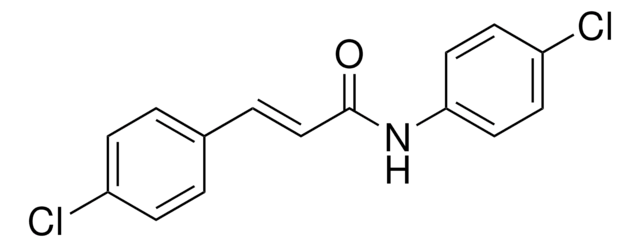A2917
Acrylamide/Bis-acrylamide
for molecular biology, BioReagent, 19:1 (ratio)
Synonyme(s) :
Acrylamide/Bisacrylamide, 19:1 (5% crosslinker), Polyacrylamide solution
About This Item
Produits recommandés
Qualité
for molecular biology
Niveau de qualité
Gamme de produits
BioReagent
Forme
powder
Ratio alimentaire
19:1 (ratio)
Activité étrangère
DNAse (exonuclease), NICKase (endonuclease), RNAse, and protease, none detected
Chaîne SMILES
NC(=O)C=C.C=CC(=O)NCNC(=O)C=C
InChI
1S/C7H10N2O2.C3H5NO/c1-3-6(10)8-5-9-7(11)4-2;1-2-3(4)5/h3-4H,1-2,5H2,(H,8,10)(H,9,11);2H,1H2,(H2,4,5)
Clé InChI
OCQZXMCGTAWGEQ-UHFFFAOYSA-N
Vous recherchez des produits similaires ? Visite Guide de comparaison des produits
Description générale
Application
- in the preparation of urea polyacrylamide gel during a modified cross-linking affinity purification protocol (cCLAP)
- in microsatellite genotyping and nonfluorescent elastin (ELN) (GT)n polymorphism genotyping
- in polyacrylamide gel for separation of proteins in SDS-PAGE for western blotting
Caractéristiques et avantages
Reconstitution
For the 1 Liter size, use 630 mL of water.
Produit(s) apparenté(s)
Mention d'avertissement
Danger
Mentions de danger
Classification des risques
Acute Tox. 3 Oral - Acute Tox. 4 Dermal - Acute Tox. 4 Inhalation - Carc. 1B - Eye Irrit. 2 - Muta. 1B - Repr. 2 - Skin Irrit. 2 - Skin Sens. 1 - STOT RE 1 Oral
Organes cibles
Peripheral nervous system
Code de la classe de stockage
6.1C - Combustible acute toxic Cat.3 / toxic compounds or compounds which causing chronic effects
Classe de danger pour l'eau (WGK)
WGK 3
Point d'éclair (°F)
Not applicable
Point d'éclair (°C)
Not applicable
Équipement de protection individuelle
Eyeshields, Faceshields, Gloves, type P2 (EN 143) respirator cartridges
Certificats d'analyse (COA)
Recherchez un Certificats d'analyse (COA) en saisissant le numéro de lot du produit. Les numéros de lot figurent sur l'étiquette du produit après les mots "Lot" ou "Batch".
Déjà en possession de ce produit ?
Retrouvez la documentation relative aux produits que vous avez récemment achetés dans la Bibliothèque de documents.
Les clients ont également consulté
Notre équipe de scientifiques dispose d'une expérience dans tous les secteurs de la recherche, notamment en sciences de la vie, science des matériaux, synthèse chimique, chromatographie, analyse et dans de nombreux autres domaines..
Contacter notre Service technique







